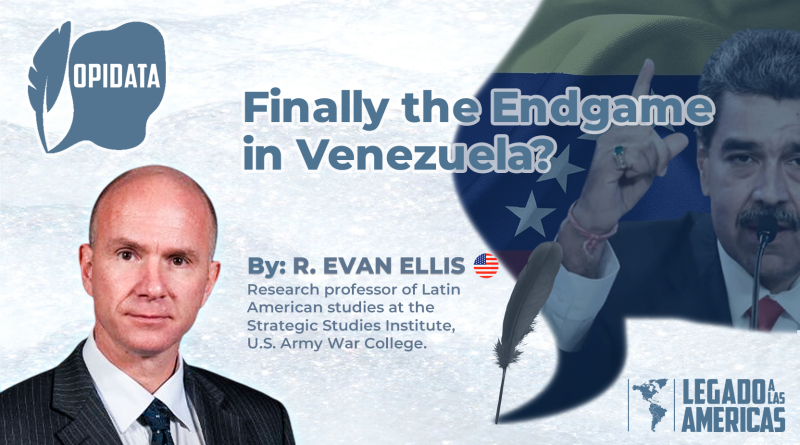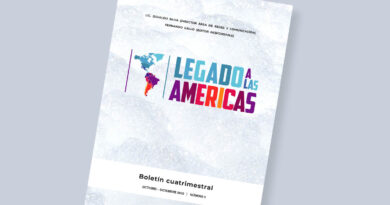Finally the Endgame in Venezuela?
✍️By R. Evan Ellis[1]
«The long overdue hour may be approaching in which Venezuelans have an opportunity to remake their country in a new democratic tradition, forged in more than two decades of suffering after allowing their prior imperfect democracy to be hijacked by Hugo Chavez and Nicolas Maduro.»
Introduction
It is easy to see the determination in the US government’s approach to Venezuela and the risk the Maduro regime in Venezuela, the de facto government, faces if it does not work to address the threats emanating from Venezuela that directly impact US objectives: stopping the flow of deadly drugs and illegal immigrants into the US. The recent attack against the speedboat is a demonstration of the US government’s willingness to escalate beyond prior restraints. The US has a range of options moving forward, which include seeing if this demonstration of force was sufficient to cause Maduro to ameliorate US concerns to additional, limited strikes all the way to a Just Cause-like operation to bring Maduro and his cronies to justice in the United States like what happened to Manuel Noriega. While President Trump played down the possibility of regime change last week, the deployment of an Amphibious Ready Group and Marine Expeditionary Unit to the region provides options for the use of force, and should regime change be placed back on the table, the fact that a legitimate, elected de jure government exists provides a potential path to a successful re-establishment of constitutional democracy in the country. Return to a constitutional democracy, however, is not a certain outcome, highlighting the need to analyze some of these options and the broader implications should they be pursued.
The Significant Possibility of U.S. Action
During President Trump’s first term in office, the Administration’s policy emphasis on Venezuela was arguably focused on the restoration of democracy. In President Trump’s second term, the lens through which Venezuela is viewed is arguably dominated by the Maduro regime’s perceived challenges to core US interests, including its facilitation of drug flows killing Americans and his authoritarianism and disastrous policies as a primary cause of migrant flows to the US (including Tren de Aragua, which has brought heightened criminal violence to U.S. cities as the group preys on those migrants). Maduro’s refusal to fully cooperate in accepting Venezuelans deported from the U.S. and perceptions that he outlasted President Trump in his first Administration arguably shapes a more sharply focused White House posture currently.
Additionally, a different set of political appointees and a reorganized National Security Council and interagency process in the current administration means that subordinates are more attuned to the President’s priorities and implementing his decisions. Further tipping the scales toward decisive U.S. action, key Administration figures who have sought to negotiate with Maduro, such as Richard Grennell, have not achieved positive results, strengthening the arguments of others, such as Secretary of State Marco Rubio, who have long been hawkish regarding Venezuela.
Next, in terms of legal authorities, the Administration has determined that the Cartel de los Soles, like Tren de Aragua, is a terrorist organization causing harm to U.S. citizens through its export of drugs. Although some have questioned the determination, it facilitates legal arguments for actions to neutralize cartel members, leaders and operations. The U.S. Administration’s use of lethal force against a 11 persons in a speedboat that it indicated was tied to the Cartel, although questioned by some, should signal to Maduro loyalists the possibility that the Administration will act against more senior Cartel de los Soles figures as well.
Complementing the Administration’s legal framework, the current U.S. military force assembled in the Caribbean is of a size and composition that provides the commander with a range of options up to decisive operations to capture or eliminate even substantially protected Cartel de los Soles figures.
At the core of the U.S. force is a Marine Air-Ground Task Force (MAGTF). It includes the U.S.S. Iwo Jima, a Wasp-class Landing Helicopter Assault Ship (LHA) capable of rapidly transporting significant numbers of embarked marines simultaneously to multiple objectives in Venezuela, via aircraft such as the MV-22 Osprey, MH-53, or MH-60, supported by AV-8 and F-35 vertical takeoff and landing (VTOL) fighters, UH-1 and AH-1 attack helicopters. The MAGTF in the Caribbean also includes two of the Navy’s newest San Antonio Class Amphibious Transport Dock (LHD) ships, whose specialty are launching rapid over-the-beach landing craft (LCACs) carrying even larger contingents of Marines and their vehicles. Over 2,000 marines, equipped and trained for such rapid air and ground expeditionary operations are likely embarked in these three ships as part of a larger force of approximately 4,500 marines and sailors. That force package is complemented by a Los Angeles Class fast attack submarine, three Navy Destroyers, including two of its newest Arleigh Burke class ships, and the Ticonderoga class Cruiser U.S.S. Lake Erie. While a key mission of these ships is to provide an envelope of protection to the amphibious ships, they also contain over 400 missile tubes between them, capable of conducting precision strikes that would easily neutralize the older generation Russia supplied S-300 and the limited number of 20-year old Chinese JYL-1 radars that are still in operation, as well as command and control nodes, older Russian supplied, poorly maintained Sukhoi-30 and F-16 fighters, Iran-supplied Zolfaghar attack boats, or other targets that could present threats to the force or obstacles to the operation.
The recent additional U.S. deployment of 10 F-35s, the Air Force’s most sophisticated and stealthy air superiority fighter, to Puerto Rico, provides further assurance of neutralizing any Venezuelan or external air threat, and possibly illustrates the degree of seriousness and detail with which the U.S. is planning for combat operations with the assembled force. The U.S. also has ample options for sending fighters, bombers, and other forces directly from the Continental United States into the fight as needed to further secure success in virtually any contemplated operation.
U.S. training activities by the embarked Marines in Puerto Rico also suggests preparation for actions and could even be used as part of initiating such an action. Moreover, the visit to the Island by Secretary of Defense Peter Hegseth and Commander of the Joint Chiefs of Staff General Daniel Caine suggests the senior-level attention being given to preparations for potential action in the Caribbean.
It is important to note that the assembled force is not of the size for a long-term occupation of Venezuela or even the type of temporary takeover involved in the 1989 Operation Just Cause which took down Panamanian narco dictator. It is thus consistent with the current administration’s general posture of shying away from costly long-term military engagements where possible.
The prospect of success of a large-scale US air and ground operation to seize Maduro and bring him to justice is bolstered by the record $50 million reward offered to those facilitating his capture. Although even this sizable amount of money is possibly insufficient for an independent “Eric Prince” style contract military operation, it may be more than enough to buy the cooperation of many in Maduros security detail and inner circle, as well as persuading select Venezuelan military units to temporarily stand down, where they might otherwise have to be taken out to reduce risk to the ingress and/or egress of any US force.
The elementary military logic outlined in this article is arguably well-known to the Venezuelan military and Maduro’s cronies, as well as the Cubans and other supporters. Indeed, this author has already heard of outreach by the Venezuelan military and others to persons tied to the de jure elected government. Individual units and Maduro-affiliated elites increasingly understand that one way or another, the current situation is unlikely to end with their patron in power, and they are thus thinking of how to save themselves from either engagement by a vastly superior U.S. force, and/or prison for crimes committed under Maduro, once rule of law is restored.
As with the approach of the current US administration in other parts of the world, such as the June 2025 US military strikes against Fordow and other nuclear sites in Iran, the current U.S. Administration’s willingness to threaten, but desire to avoid military action where possible, implies that the U.S. force in the Caribbean may not immediately launch a major operation, but conduct a series of actions with that force, based on how Maduro and regime loyalists respond, taking advantage of opportunities that present themselves, and only conducting a major operation if other alternatives have been exhausted, yet while still preserving the element of strategic surprise.
The large number of US marines and others embarked on warships in the Caribbean implies that the US time horizon for resolving the present confrontation is not infinite. Still, the US arguably has flexibility of time and numerous options for a graduated response, and with the use of deadly force against an alleged Cartel de los Soles affiliated drug boat, the US has shown its disposition to act in this fashion.
If the US does commit to a large-scale operation, the biggest uncertainty is probably not operational success but extracting Maduro alive. There are arguably many in Venezuela who would prefer that Maduro’s secrets die with him, rather than coming out in interrogations in the US with the Justice Department and intelligence community.
The biggest risk of a military operation in Venezuela which captures or eliminates Maduro and a portion of his cronies is the escalation of violence. Maduro’s predecessor, Hugo Chavez, and Maduro himself have arguably set up the country as a criminal franchise in which the military, Maduro’s cronies, and others have long been complicit. As a consequence, as noted previously, the disappearance of Maduro and those close to him is less likely to facilitate a transition to democracy than a scramble by the country’s numerous criminal actors to grab power for themselves and undermine any establishment of order by a democratic government that could hold them accountable for their crimes. These problematic dynamics would also be complicated by others such as Russia, Cuba, and China, each with a vested interest in denying the US a “victory” on Venezuela, and sowing chaos that distracts the US, consumes its resources, and taints it in the international court of public opinion, seeking to exploit the perceived US role in unleashing the chaos in Venezuela through its military actions.
Despite this pessimistic outlook, US military action would still give the legitimate Venezuelan democratic government of Edmundo Gonzalez a slim, fleeting opportunity to restore democracy that they should recognize and prepare for. Their empirically demonstrated receipt of 67% of the votes of the Venezuelan people during the July 28, 2024 national elections gives them an inherent legitimacy that would lead many, including even criminal elements seeking stability, to attempt to construct a new government around them.
Following a US intervention, it would probably not keep significant military forces in the country longer than necessary. As a consequence, the onus would be on Edmundo Gonzalez or any transition government to rapidly establish order and address immediate needs and fiscal, economic, and legal challenges. Any new government would have to build a reliable military, likely working with questionable units from the past regime, while convincing criminal actors, citizen militias, and other actors previously affiliated with Chavismo that it is in their long-term interest to support the peaceful restoration of democracy rather than sabotaging it.
The fragile new government would also have to work quickly to generate and capture revenues, including restoring oil production and refinement, as well as future expanded production capacity. To do so, it will have to make difficult choices about reaching out not only to the US and other western companies, but possibly also to existing key players such as Russia and China.
The new government would also have to rapidly address the country’s financial crisis including an estimated $140 billion in outstanding debts incurred by the expropriations and mismanagement of the Chavez and Maduro regimes. It would similarly have to deal with pressing legal actions and judgments in multiple international courts against the government if it is to restore Venezuela’s access to external commercial and financial markets.
If this were not enough, the new government also will face the onerous task of reuniting a deeply fractured and polarized country, building a sense of Venezuelan national unity of purpose.
Conclusions
The long overdue hour may be approaching in which Venezuelans have an opportunity to remake their country in a new democratic tradition, forged in more than two decades of suffering after allowing their prior imperfect democracy to be hijacked by Hugo Chavez and Nicolas Maduro.
Venezuela’s route forward will be perilous. The vast majority of the work and risk will probably have to be borne by Venezuelans themselves without the guardrails of significant US military or financial support. Indeed, as of the date this work was published, neither Maduro’s fall, nor the success nor democratic character of what follows is guaranteed.
If there is one source for hope, post-Chavez Venezuela has never had a better prospect for liberation or a more improbable liberator. Nor has it previously had a de jure “opposition” government with a greater mandate or style for forging national unity than it currently has with Edmundo Gonzalez and Maria Corina Machado and her valiant supporters. Victories are never assured, but no tragedy lasts forever.
[1] The author is Latin America Research Professor with the U.S. Army War College. The views expressed herein are strictly his own.
This article is part of Opidata, the editorial platform of Legacy to the Americas for the analysis of key issues in the region.
🔍 More content at 👉 https://legadoalasamericas.org
📩 To receive new articles, subscribe to our newsletter or follow us on social media.




